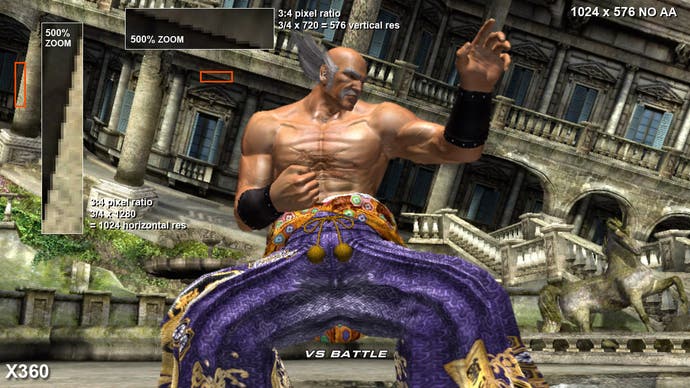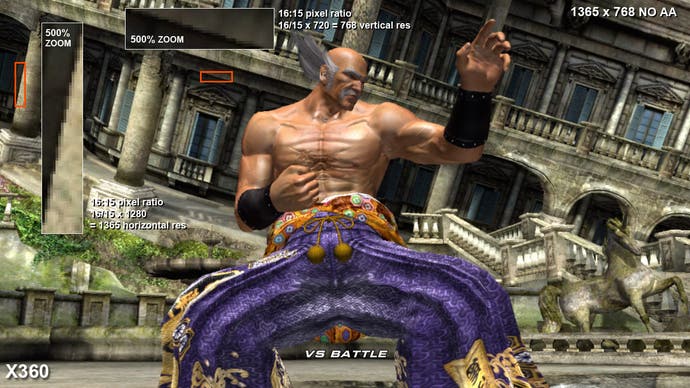Tekken 6 PS3/360: The resolution game
In Saturday's Digital Foundry "not so high definition" feature, we talked about the technical reasons why some console games don't actually appear to be running at the lowest HD standard: 720p. We revealed that Namco-Bandai's forthcoming Tekken 6 is one of those games, but also stated that the additional graphics processing introduced at the lower resolution, surprisingly, produced a higher overall image quality than the game's in-built HD mode which actually runs in excess of 720p.
Our analysis was exclusive to the Xbox 360 version of the game, and we promised an update on the PS3 rendition, so let's get going. To put it simply, there's good news and bad news here. Let's get the bad tidings out of the way first: while there is the option to switch between 1024x576 and 1365x768 modes on Xbox 360 (via tweaking the motion blur setting between on and off), the PS3 version is locked exclusively to the lower resolution. The good news is that even so, the PS3 version still manages to command a slightly higher image quality overall if you can do without the motion blur.
Let's get the pixel measurements out of the way first, courtesy of DF contributor and image quality specialist, MazingerDUDE.




Removing the motion blur filter frees up a lot of resources, and Namco has chosen to deploy these in two different ways on each console. Xbox 360 gets an enormous resolution boost to 1365x768, while the PS3 gets 2x multi-sampling anti-aliasing. In terms of overall image quality across the two modes and two consoles, the PS3 gets the nod in "blur off" mode thanks to decent enough upscaling based on an anti-aliased image, while in default mode with the motion blur active, the 360's enhanced texture filtering gives clear image quality advantages.
So why did Namco choose 1365x768 on 360? If the dash is set to 1360x768, you don't get close-to-native resolution as you might expect. Indeed, the image is scaled down to 720p internally, then scaled back up by the Xenos GPU. Namco's methodology here is to smooth off edges by rendering at a higher resolution then scaling down – the developers have done it before, not just in Soul Calibur IV, but also in Ridge Racer 6. It's an attempt at some form anti-aliasing without needing to tile video data out into main RAM. At 1365x768 with no AA, everything remains inside the 360's 10MB eDRAM, ensuring maximum performance.
Despite that, we can conclude that Tekken 6 at sub-HD resolutions gives a better-looking display at 576p. So, what's going on, particularly in the Xbox 360 game? How can the sub-HD mode give clearer, sharper detail when it's running at nearly half the resolution of the "motion blur off" mode? Time to call in an Xbox 360 development expert, someone used to pushing the hardware in obscure directions: Trials HD lead coder Sebastian Aaltonen.
High quality motion blur consumes a lot of performance. If you want something else than camera motion based blur, you have to save the motion vectors for each pixel, so the render target memory requirement rises as well. 88 (16-bit) would be enough for 2d screen space motion vectors, but for practical reasons you need an 8888 buffer.
1365x768 resolution 8888 color + 24S8 depth = 8386560 bytes, while 1024x576 resolution 8888 color + 24S8 depth + motion vectors = 7077888 bytes
Both configurations fit well inside the 10MB eDRAM. The 1024x576 is kind of a strange choice, as it's only around half the pixels of the 1365x768 and the cost of the blur filter comes nowhere close to the performance gained from the resolution decrease, and they are not eDRAM limited either. The resolution reduction itself is not something I consider strange, but a reduction this large means they have something else going on than just the motion blur. The better texture detail you are seeing could mean they have enabled anisotropic filtering for the lower resolution.
So, as we previously discussed, sub-HD is most often used to make up for performance deficits, but with Tekken 6, Namco-Bandai has opted to effectively include two different performance profiles.
In terms of how this works out during gameplay, the motion blur itself is quite a subtle effect, but pleasing nonetheless. Blur works best as a means of making motion look smoother than the frame rate suggests, but Tekken 6 is effectively locked at 60FPS any way, so the overall impression is not as impactful as the similar systems employed in Killzone 2 and Uncharted 2. However, the game includes at least two boss-style battles that pitch your fighter up against enormous, screen-filling opponents. And in those cases, the blur is much more evident. But in truth, as effects go, we can take it or leave it.
Overall, although there's really nothing in it in the heat of gameplay, we'd take the PS3's blur-off 576p 2xMSAA picture as the best IQ option available across both versions, the realisation of which suggests that the whole game would've benefited a lot more with the more traditional arrangement of native 720p and MSAA. Screen-filling bosses aside, there's nothing to suggest that this wouldn't have been possible. It's interesting to note that even when Tekken 6 is running at an HD resolution there is the sense that the game isn't quite all it could've been visually.
So, while we're here are there any other technical issues of note? There's a lot of Soul Calibur IV DNA in here, that's for sure, extending beyond the native resolution of the Xbox 360 game. Just like Namco's previous fighting game, the PS3 game gets an "install to HDD" optional feature (around 3.6GB in our preview code) and this is well worth using – load times can be laborious without it. It is worth pointing out that stuff like disc layout issues are optimised in the final period of development so in this case, the non-final nature of the code may be an issue, but there's nothing here that we didn't experience with Soul Calibur IV too. We'll be updating from final code in a future Face-Off, but with the game just weeks away from release, we're not expecting major changes.
One thing that is admirable is that there's also obvious evidence of Namco making use of the extra space on the Blu-ray disc. Tekken 6 data weighs in at around 20GB. Bearing in mind the size of the install, it's fair to assume that the rendered movies get the benefit here. That said, in the Tekken Force "Scenario Mode", cut-scenes are generally engine-driven using in-game assets, running at 60FPS on both consoles and are of essentially equal quality. Intro and ending movies tend to get the full-on CG treatment beloved of the Tekken series, and it's good to know that Namco-Bandai has taken a zero compromise approach to them, using the maximum bandwidth available that the freedom of a 25GB Blu-ray disc offers.
Moving away from DF issues and back into "preview mode", it will be interesting to see what the reception is to Tekken 6 from the media and gamers alike. Just like Soul Calibur IV, the core mechanics of the game harken back to previous games in the series, and the sense of re-invention we had in Street Fighter IV that made the genre feel somehow more fresh does appear lacking here. That said, it is interesting to note that the Tekken Force "Scenario Mode" is the first selectable option on the main menu - clearly Namco-Bandai wants us to give this a whirl first, and to try out the traditional one-on-one modes later.
Tekken 6 is slated for release at the end of the month.







